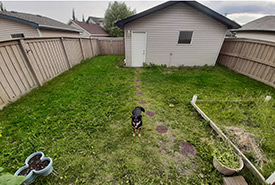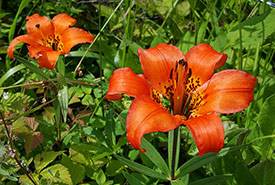Lasagna garden

My dog, Kahlua, in her new backyard (Photo by Carys Richards/NCC staff)
This summer I purchased a house, and alongside the responsibility of being a first-time home owner came the excitement of having my own yard to create a garden in.
When I took possession of the house, the backyard looked a lot like this: flat and grassy with some dandelions and a deck. There were the remains of one old garden area that had long been abandoned, evidenced by some two-by-fours placed along the ground, surrounding the remains of some green onions, thistle plants and a whole lot of long grass. But when I looked out into this sunny south-facing backyard, I saw a world of possibilities.
Ever since I moved out of my parents’ house for the first time at age 17, I’ve lived in apartments and townhouses in numerous towns and cities across Alberta. I’ve always had a deck or a patio — my small slice of the outdoors in which to enjoy fresh air and sunshine — but this is the first time I’ve had my own yard to thoroughly enjoy.
I have big plans for this yard: trees, vegetable gardens and native flowers. But I’ve never converted a green-grass yard into a garden space before, so I began doing some research into different methods and talking to my co-workers with more gardening experience than me. One method a co-worker of mine talked about was a technique called a "lasagna garden."
Related blog posts
Lasagna garden refers to the method of layering ground cover, and not what you’ll be growing. One of the main reasons this method looked so appealing to me is because it does not involve digging into the ground, so it sounds like a lot less work than a traditional garden bed.

Lavender flowers (Photo from Pixabay)
So how, exactly, does a lasagna garden work? The gardener (that is, me) begins by laying down newspaper or cardboard. Having recently moved, I conveniently have an abundance of carboard boxes lying around. This newspaper/cardboard layer smothers the grass and weeds that are growing underneath, eliminating the need to dig.
From here, it’s a simple matter of alternating brown and green layers. Brown, or carbon-based, layers can include fall leaves, shredded cardboard or newspaper. Green, nitrogen-based layers can include grass clippings, vegetable scraps or coffee grinds. You can also add compost, manure or straw, and water down the area between layers.
Pile the “lasagna” until the garden is about two feet tall, because as the elements break down it will shrink in size.
Top the whole thing off with a layer of topsoil, and then let nature do its thing!

Western red lily (Photo by Sarah Ludlow/NCC staff)
While a lasagna garden can be started at any time, my research indicates that the best time of year to begin this process is in the fall, as this allows the garden to break down all winter. Rain and snow will keep the garden moist, which will help break down the materials, and come spring, the area should be ready for planting.
That sounds pretty easy, right?
Now, I can sit on my deck and plan out where I want my gardens to go. This fall I’ll get started, and hopefully by next summer, my flowers will be growing out of my newly formed garden instead of out of flower pots.


